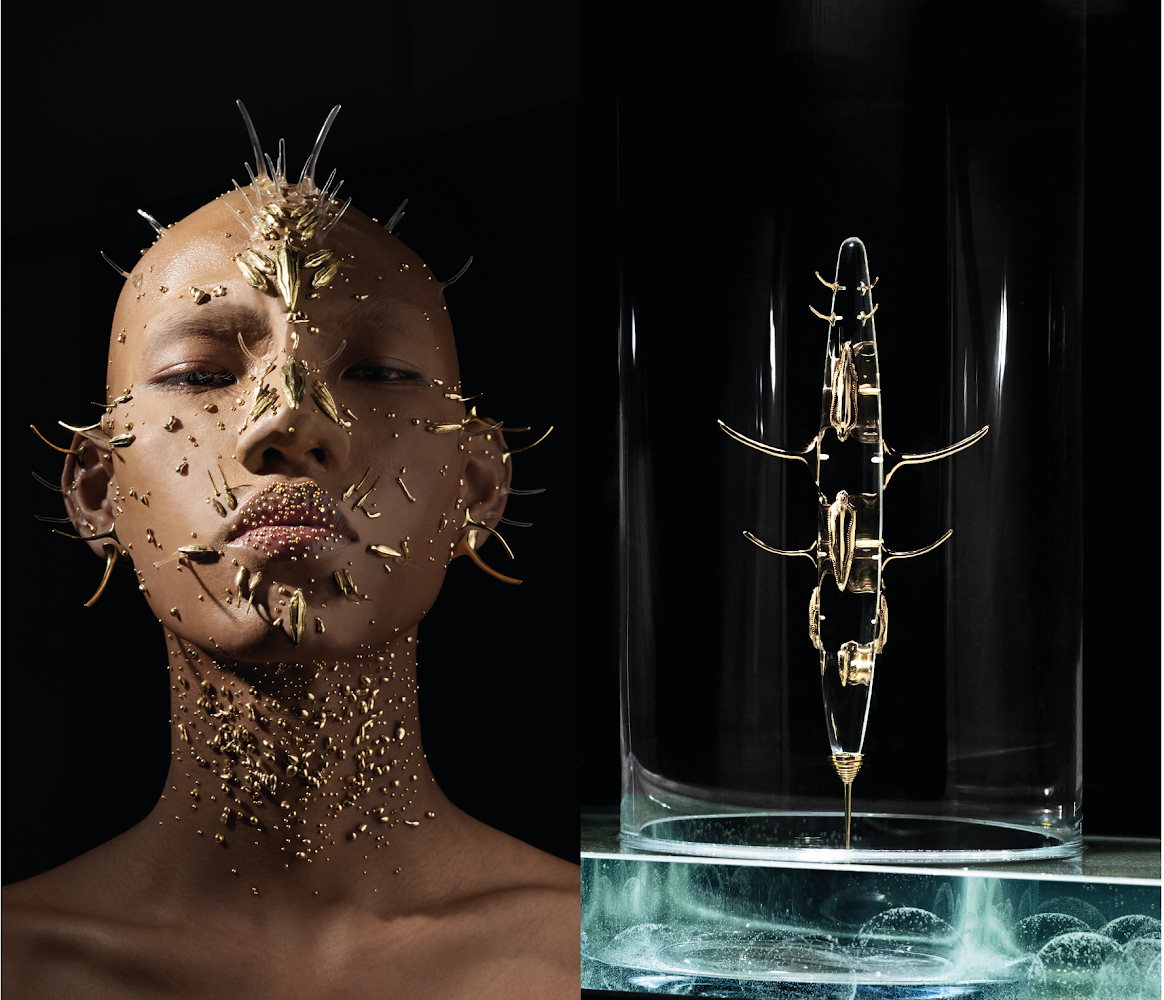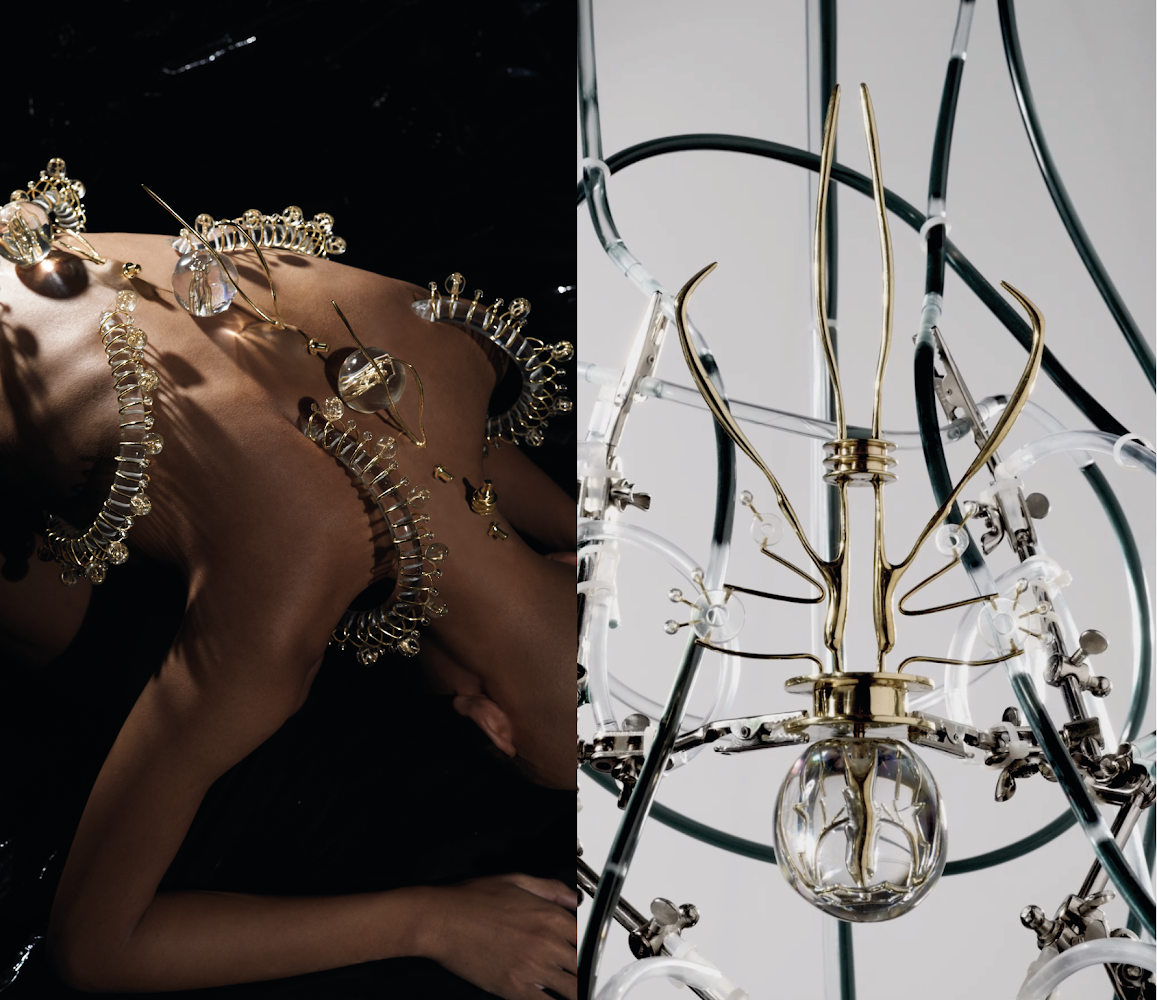permanent collection Design Museum Denbosch, Netherlands
solo exhibition 27 September 2023 - 23 June 2024
TANEM FIUJA or ‘exchanging future’, in Bichlamar (the local Vanuatu language) explores the concept of scarification in a far-flung future. Loan Favan contemplates whether future humans will still endure scarification, which animals will inspire them in their rituals and which extraordinary powers they will seek. TANEM FIUJA is a collection of ritualistic ornaments and speculative scarifications. The work describes a series of futuristic rituals with which hypothetical humans protect themselves from the passage of time and attempt to become invincible and immortal. TANEM FUIJA collection consists of 3 monumental jewelry look and 3 ritualistic tools.
PLANEM RUS (‘growing roots’)
This work is inspired by the planarian, a microscopic flatworm that can regrow body parts and organs. When cut in two, the planarian worm becomes two new worms, making it functionally immortal. In this speculative design, future humans use planarian-inspired implants as a new reproductive technology. Loan Favan envisions a world in which humans can regenerate tissue and even split themselves, planarian-style, in two. But can the human soul also be multiplied in that process?
PLASEM (‘add up’)
tool: resin and brass 22x11x2cm
This piece is the ritualistic tool used in PLANEM RUS scarification ritual. PLASEM tool merges the implant matters to the skin and injects a part of the implant below the skin surface.
PLASEM is composed of an intricate cylinder where the implantz can be placed and be prepared for procedure on a 4-axis hook.
LAEF OLBAOT (‘alive everywhere’)
This work is inspired by the tardigrade, an 8-legged animal of about 1 millimeter, capable of withstanding extreme environments (surviving from -273°C to +340°C). When faced with conditions that are too extreme even for the tardigrade, it goes into hibernation, enabling it to survive the harshest environmental circumstances. With LAEF OLBAOT, Loan Favan proposes a series of protective implants that would turn into powerful shields for the body of future humans. The speculative implants create a protective layer and function as three new spines, allowing the body to curl up and enter a long-term hibernation to survive any life-threatening situation.
KATEM (‘to cut’)
tool: resin and brass 23x19x1cm
This piece is the ritualistic tool used in LAEF OLBAOT scarification ritual. KATEM is a double-headed knife that facilitates the insert of the pieces deep within between skin layers. The series of implants are installed from behind the ear to the shoulder, as a body shield.The ritual to install all pieces lasts from 5 to 10 days depending on the healing process.
BON BAKEGEN (‘born again’)
This work is inspired by the so-called immortal jellyfish, or turritopsis nutricula. Upon reaching adulthood, this jellyfish can revert its cells back to childhood, reversing the aging process and extending its lifespan. It never dies of old age. BON BAKEGEN enables Loan Favan to imagine future humans becoming immortal using implants inspired by the jellyfish. BON BAKEGEN would be ritualistically installed by the family members at birth: a futuristic way to baptize and allow their newborn to access another life, an eternal one.
OLTAEM (‘always’)
tool: resin and brass 25x11x5cm
This piece is the ritualistic tool used in BON BAKEGEN scarification ritual. OLTAEM is a magnetic tool used to install the implant structure. The ritual of BON BAKEGEN takes place during the embryo state of the patient. While the embryo is still in the womb of their mother, the tool is placed all over the belly and back of their mother.
_
_
credits:
photography: Tyson Ernste, mua: Adara Tresna, model: Lintang represented by Persona Bali
supported by:
creative industries fund NL Stimulerings Fonds, Design Museum Denbosch, Stichting Stookroos



